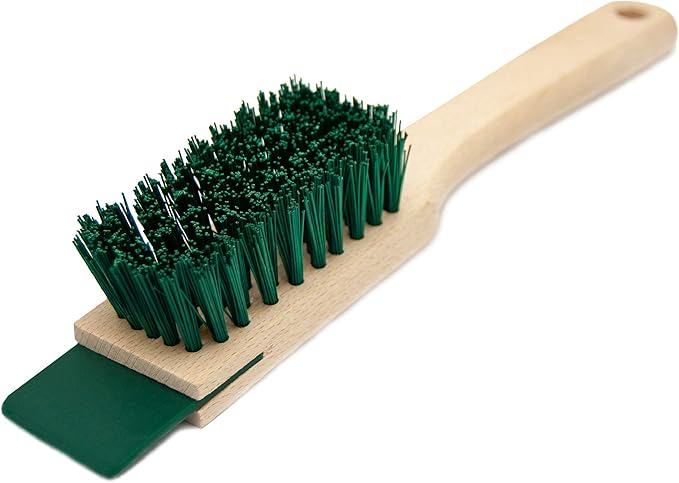Scrubbing decks, cleaning patios, or tackling tough grime on outdoor surfaces often involves a trusty outdoor scrub brush. While these tools are invaluable for deep cleaning, they can also take a toll on your hands. Blisters, cuts, and general wear and tear are common hazards. This guide will help you understand the risks and equip you with the knowledge to protect your hands while getting the job done.
Understanding the Risks: Why Hand Protection Matters

The repetitive scrubbing motion, combined with the often harsh nature of cleaning solutions and the rough surfaces being cleaned, can quickly lead to hand injuries. Even seemingly minor irritations can escalate into painful conditions if neglected. Common problems include:
- Blisters: Friction from the brush handle and the scrubbing action cause blisters, making continued work painful.
- Cuts and Abrasions: Rough surfaces or sharp debris can cause cuts and scrapes on your hands.
- Contact Dermatitis: Exposure to harsh cleaning chemicals can irritate and inflame the skin, causing redness, itching, and dryness.
- Carpal Tunnel Syndrome: Repetitive hand movements over extended periods can contribute to this painful condition.
- Tendonitis: Inflammation of the tendons in your hands and wrists can result from overuse.
Protecting your hands is not just about comfort; it’s about preventing long-term health issues and ensuring you can continue enjoying your outdoor projects.
Choosing the Right Gloves: A Guide to Hand Protection
The best type of glove for scrubbing depends on the specific task and the cleaning solutions being used. Here’s a breakdown of popular options:
- Leather Gloves: These offer excellent protection against abrasions and cuts. They’re durable and long-lasting but can be less comfortable in hot weather. Look for gloves with reinforced palms and fingertips.
- Nitrile Gloves: A great choice for chemical resistance. They offer a good barrier against cleaning solutions but may not provide as much protection against abrasions.
- Cotton Work Gloves: These provide basic protection against minor abrasions and offer good breathability. They’re ideal for lighter cleaning tasks but not suitable for harsh chemicals.
- Gardening Gloves: Many gardening gloves incorporate reinforced palms and fingertips, making them a good option for scrubbing. Choose gloves made from durable materials like nylon or leather.
- Specialized Scrubbing Gloves: Some manufacturers offer gloves specifically designed for scrubbing, often incorporating textured palms for enhanced grip.
Remember to choose gloves that fit well – gloves that are too loose or too tight can be uncomfortable and less effective.
Beyond Gloves: Additional Safety Tips

Gloves are a crucial first step, but several other practices can enhance your hand protection:
- Use a Long-Handled Brush: Whenever possible, opt for a scrub brush with a long handle to keep your hands further from the cleaning surface.
- Take Frequent Breaks: Avoid prolonged scrubbing sessions. Take breaks to rest your hands and prevent fatigue.
- Proper Posture: Maintain good posture to avoid straining your wrists and hands.
- Use the Right Tools: Don’t rely solely on brute force. Use appropriate tools for the task, such as a pressure washer for heavier cleaning.
- Protect Your Skin: Before starting any cleaning project, apply a protective hand cream to create a barrier against harsh chemicals and reduce dryness.
- Clean your Gloves Regularly: Dirty gloves can harbor bacteria and dirt, which can irritate your skin. Clean your gloves after each use and allow them to dry completely before storing them.
Addressing Specific Cleaning Challenges

Different cleaning tasks demand different approaches. For example, scrubbing a rough stone patio might require tougher gloves and a longer handled brush than cleaning a smooth wooden deck. Consider the surface you are cleaning and choose your tools and gloves accordingly. If dealing with particularly stubborn grime, consider pre-soaking the area to loosen the dirt before scrubbing.
Maintaining Your Hands: Post-Scrubbing Care

After you finish scrubbing, take care of your hands to minimize irritation and promote healing:
- Wash your hands thoroughly: Remove any remaining cleaning solution and debris.
- Moisturize: Apply a generous amount of hand cream or lotion to hydrate your skin and prevent dryness.
- Treat any cuts or blisters: Clean and dress any wounds to prevent infection.
- Rest your hands: Allow your hands to rest and recover after prolonged scrubbing.
By following these tips and choosing the right protective gear, you can enjoy the benefits of a sparkling clean outdoor space without sacrificing the health of your hands. Remember, prevention is key! Prioritizing hand safety ensures you can keep tackling those cleaning projects for years to come.